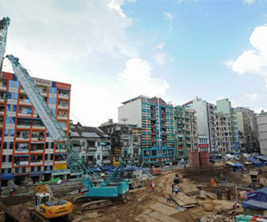For 2015, the Economist Intelligence Unit forecasted Myanmar to attain a per capita GDP of $970. With
growth projected at more than 7% and sus- taining this, the country is poised to catch up with the rest of the key ASEAN mem- ber-countries. This situation was unexpect- ed when the transition to civilian govern- ment and democratization started several years ago. Beside the efforts at improving human rights record, the government of President Thein Sein initiated a number of reforms that made the country the darling
of investors and development institutions. Some observers compare the present stage of the country with the democratization process undergone by other neighbouring ASEAN member-countries particularly Viet- nam with its policy of doi moi in the 1980s and with Cambodia in 1990s. Both of these countries were able to maintain stability and have moved up economically.
It is too early to conclude but questions are begging for answers at this point. What
are the impacts of the reforms on the so- ciety in general and the common people in particular. Has the reforms improved the living standard of the common people? Are the changes being felt and seen by the people? The questions are relevant now as Daw Aung San Suu Kyi has stated that the reforms have been stalled. If it has indeed stalled, the spectre of return to the old or- der is too much to bear for most people. The present government will be judged as either
the force that facilitated the return to de- mocracy or the one who hindered the coun- try’s move towards a better future. This is- sue will definitely be one of the main issues of the coming election.
Reforms and tangible impacts
A cursory look at some sectors would give us insights on the impact of the reforms on the poor. The first would be the financial sector, and money being the lifeblood of an econo- my, access to financial services will have one of the most tangible impacts to common peo- ple. Two main government initiatives in this sector have the biggest impact. The first is the passage of the Microfinance Law in Novem- ber 2011, opening the floodgates of financial services to the poor. The law facilitated the licensing of hundreds of microfinance insti- tutions, enabling the entrepreneurial poor to venture into productive income generating activities. The second is allowing the entry of foreign banks who are infusing not only fresh capital to the economy but also introducing business practices that would influence local banks to enhance their way of doing things. Indeed, these reforms have energized the economy not only in the urban areas but the countryside as well.
Another important reform is the Farmland Law passed in March 2012 allowing for the use of land certificates that can be sold and mortgaged. This is expected to support the agricultural sector. For some enterprising farmers or rural entrepreneurs, this will provide another avenue to mobilize capital when they expand or when they decide to venture into non-agricultural enterprises. The downside of this is another law, the Va- cant, Fallow and Virgin Land Management Law which allowed the development of land by foreign investors through joint ventures with local companies.
The Foreign Investment Law passed in No- vember 2012 is another big milestone. It allowed the entry of multinational corpora- tions and infusion of fresh funds to various business sectors. Quality products and ser- vices are made available providing a wide range of choices from the cheap and afford- able to high-end luxury items. It has also generated employment opportunities and has initiated upgrading of standards and practices in international businesses which is hoped to influence in improving the com- petencies of local companies.
Real estate offers the most tangible results as construction activities mushroomed not only in Yangon and Mandalay but in key cities and townships as well. Hotels, condominiums, shopping malls and other constructions are gradually changing the skylines of Yangon and other cities. Public infrastructure also got a boost from multi- lateral agencies lending institutions to help improve roads, bridges, ports and airports and opening up roads in areas where there were previously none.
Tourism is another sector that has gained much in the series of reforms. It recorded 1 million tourists in 2012 and projected to increase more than double this year. A sharp increase in the number of tourists mean more money spent in key tourist ar- eas, employing people in the establishments and support small and medium enterprises geared towards the industry. Reforms in im- migration like on-arrival and e-visa further support reforms in this sector.
One of the most welcome changes is the lib- eralization of the telecom industry. With the commencement of operations of Telenor and Ooredoo, mobile phones become ubiq- uitous gadgets. It has empowered common people and ensures connectivity. Other ser- vices like mobile money when introduced later will open more opportunities for the common people.
There is no doubt on the positive impact of the reforms to the people. It has provided access to products and services, employ- ment opportunities and income generat- ing activities, and upgraded infrastructure. However, negative impacts are also ob- served as dispossession of ancestral lands due to land grabbing is happening. Negative influences to the culture and attitudes of the younger generation can be observed. It may not be visible now, but the gradual widening of gap between the rich and the poor will gradually be evident in the future.
Election will decide
The government have done much considering the time, but they could have done more. Almost 4 years since the start of reform, there is a perception that the reforms have stalled.
There are more things to be done to maxi- mize the initial reforms but observers are feeling that the follow-up initiatives are lacking. To look at it from another perspec- tive, it is believed that there are some forc- es that are hindering the reform process to protect their vested interest. At this point, the government cannot be too cautious and thus become so slow since they will miss op- portunities that may not come back. They also cannot be reckless and fast because they may fail to see the risks and more long term negative impact to the people and the envi- ronment. What they need now is prudent actions based on sustainable and equitable development.
Looking at the current development sce- nario, Myanmar is till the “apple of the eye” of most investors. China and India, two big neighbours are vying for its attention. A continuing environment of reforms will surely push the US and the EU to the possi- ble further lifting of sanctions that will boost the economy and sustain the gains that it has started. It has also to consider regional issues like the ASEAN economic integration that despite scepticism of some will push through and with very little possibility of being reversed. Grants and soft loans from multilateral agencies will continue to pour in to assist the country catch up with the rest of the world.
The coming elections will put spotlight on the current government and will also be the crucible for their continued leadership of the country. The people may give them credit for the tangible changes felt and seen, but others may look for what they should have done, when they know that they could have done more.











